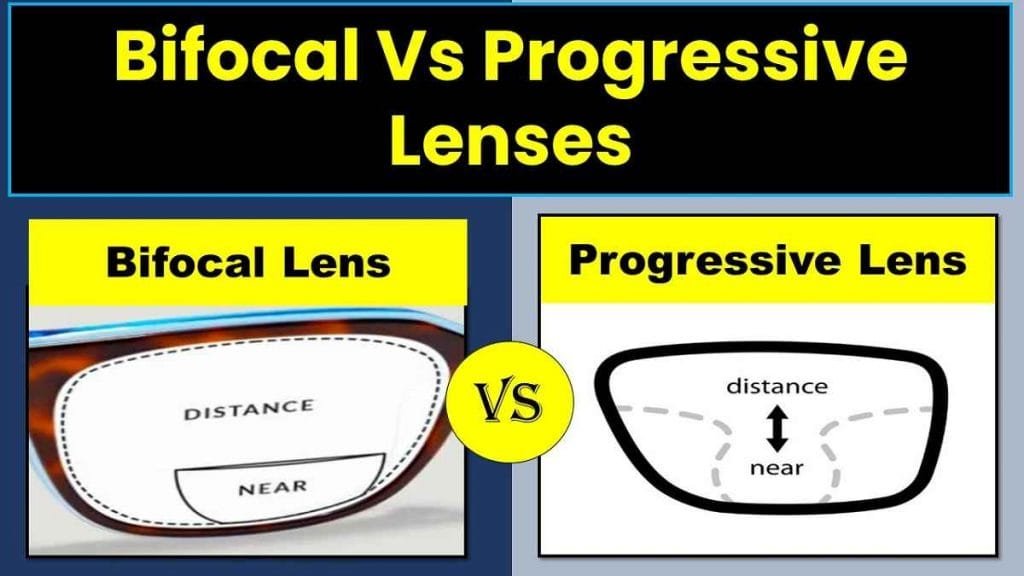What’s the difference between bifocal and progressive lenses? Which one is better for you: Bifocal vs Progressive Lenses? Why does your optometrist recommend these lenses for you?
These are some questions that you may face when buying a pair of eyeglasses after the forties. Today’s article on the topic ‘bifocal vs progressive lenses’ is designed to address those questions and allow you to make an educated decision.
Introduction
Progressive lenses (PAL) and bifocal lenses are good options if you have presbyopia. Eye care professionals often recommend these types of lenses because they help you to see things at far and up close clearly.
People who put on a pair of progressive or bifocal glasses might think that the only difference between these two lenses is the price. However, this is far from true.
While both types of glasses provide excellent vision correction and the ability to see both short and long distances at the same time, they also differ in several ways – both positive and negative.
When choosing which lens is right for you, it’s important to understand what each of them offers.
We’ll explain the differences between bifocal lenses and progressive lenses and the advantages and disadvantages of the two. Before that, let’s learn what actually are bifocal lenses and progressive lenses.

What is a Bifocal Lens?
Bifocals have been used in eyewear for over 300 years, providing wearers with two distinct vision zones – one for near vision and one for distance. In addition to the two zones, there is a distinct line separating the powers.
This can be advantageous for people with less than perfect vision who require a correction for both near and distant vision, too. While the bifocal lens has proved to be useful for many, it can also cause issues for those who have to look at the intermediate distance, such as computer work at long working distances.
To overcome this issue, a progressive addition lens (PAL) has been introduced in the eyewear industry.
Types of Bifocal Lenses
It’s important to know what the different types of bifocal lenses are in order to make an educated decision regarding which type will be the best fit for you.
There are several different types of bifocal lenses. Functionally, each lens type is the same, and the decision of which type works best comes down to personal preference.
– In the old design, a flat-top bifocal distributes the same amount of power evenly across the top and bottom of the lens. But in the new design, D-bifocal is known as flat-top bifocal where the top of the bifocal segment is flat. This type of lens is often used by those unable to wear trifocals or progressive lenses.
– A round segment bifocal has segments that curve downward toward the wearer’s face and have a similar appearance to progressive lenses. The segments are smaller than those found in a progressive lens and they do not extend as far out from the face.
This type of bifocal is often chosen by individuals with mild presbyopia who would like a small amount of magnification but do not need reading glasses for near tasks as well as distance vision correction.
While wearing this style of bifocal it is possible for people at a close distance to see only one or two segments instead of having both eyes corrected at once.
– An executive bifocal may be worn by those individuals who need much more near correction than distance correction, such as an optometrist, ophthalmologist, or medical doctor.
Progressive Lenses
Progressive lenses provide vision correction for patients who have presbyopia. Unlike bifocals, which divide the lens into two with different prescriptions, progressives allow the wearer to see clearly at all distances through a single lens.
PALs provide varying magnifications for different distances. These are also called multifocal lenses because they provide the wearer with the ability to see both near and far objects in greater clarity.
The different magnifications of lens area due to change in curvature of the lens create clear vision between both near and distant objects as well as intermediate ones, making progressive lenses ideal for computer users and other wearers who spend much of their day reading or doing close work.
How Bifocal and Progressive Lenses Work?
To understand why progressive and bifocal glasses can be more comfortable for distance and near use, it is important to understand how the eyes work.
The eyes have the ability to focus on objects both near and far and are able to move from focusing on near objects (e.g. your computer screen) to focusing on objects that are farther away (e.g. watching TV).
In order to allow for this change in focus after 40, near presbyopic correction power (near addition power) is used on the lower portion of the glasses, and distance correction power is kept on the upper area. Refractive powers allow for an image to be sharp and clear when you look through a pair of glasses (either bifocal or progressive) at any given distance.
Bifocal Vs Progressive Lenses
A bifocal lens has two vision zones or segments, the upper one for distance vision and another lower portion for near vision. But progressive lens lacks visible segments or vision zones.
Likewise, the bifocal lens has a distinct line separating the two segments of refracting powers, whereas PAL lacks such a line.
Provision of intermediate power zone is found in between distance power and near power in the progressive lens for maintaining clear vision while looking at the intermediate distance. Any types of bifocal lens lack an intermediate power segment or zone.
Bifocal lenses may cause difficulty reading any materials on the computer screen at the intermediate distance (farther than 40 cm), and increase the likelihood of computer vision syndrome. But progressive lens provides effortless clear vision at such screen distance and helps to prevent eye strain and reduces the chances of digital eye strain.
Similarly, one of the plus points of bifocal is that it provides a wider area for near power, as a result, it becomes easier for you to spend a long time reading books and doing other tasks within arm’s length distance.
From a cosmesis point of view, no line multifocal or progressive lens is considered more appealing than the bifocal with visible lines separating two vision zones.
Can I Transition from Bifocals to Progressive Lenses?
If you’re wondering if you can transition to progressives from bifocals, there are a few considerations that may help you determine if this is the right move.
The first important thing to consider is your near working distance. If you have to spend hours working on a computer screen, better to go for a progressive lens rather than to stick to bifocals.
In contrast, if you spend the majority of your time reading books continue using bifocals as it provides a wider area for near vision.
Takeaway
Selecting eyewear particularly after 40 can be a bit tricky as the choice between a bifocal and progressive lens depend on several factors, such as prescription, working distance, age, and visual needs and preferences.
Each of these options, either bifocal or progressive lens offers distinct advantages and disadvantages but either way you turn you’ll find yourself looking clear and crisp every time for all distances.
As with any vision correction, ask your optometrist which option is best for your specific needs.
We hope today’s article on ‘Bifocal Versus Progressive Lenses’ Provided you with a clear insight on the topic. If you have any doubts let us know at info@healthkura.com.
Sources
- https://www.webmd.com/eye-health/about-progressive-lenses
- https://www.allaboutvision.com/lenses/multifocal.htm
YOU MAY ALSO LIKE
Diplopia Charting: Common Method of Double Vision Test
Night Myopia (Nocturnal Myopia) – Causes, Treatment, & All
Nearsightedness (Myopia) – Causes, Treatment, & More

